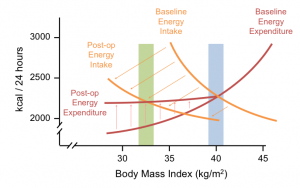Blog post updated November 2020.
Weight loss surgery is by far the most effective method for losing weight and keeping it off. In a blog post entitled The Body Weight Set Point Prevents Weight Loss, I discuss why non-surgical methods for weight loss almost never work – they don’t change the set point. In this post I discuss why weight loss surgery (gastric sleeve, gastric bypass) works – weight loss surgery lowers the set point.
The assumption until recently has been that weight loss surgery works by “restriction.” That is, surgery forcibly “restricts” the amount of food a person can consume.
This theory, however, is incomplete. The fact that non-operative forms of dietary restriction – diets, jaw wiring – don’t work long-term, whereas surgery does, suggests that there is something more going on.
In fact there is something more going on. We have learned that weight loss surgery works primarily through “physiologic” mechanisms rather than mechanical mechanisms like restriction. In other words, surgery (both gastric sleeve and gastric bypass) changes how the body functions so that the body accepts a lower weight as its “set point.”
About Body Weight Set Point
I discussed the concept of body weight set point in detail in The Body Weight Set Point Prevents Weight Loss. To review, body weight is tightly regulated within a narrow range (known as the set point) by a complex regulatory network that controls hunger and metabolic rate. Diet-induced weight loss to below this range causes this system to increase hunger and decrease metabolic rate, ultimately resulting in weight regain back up to the set point. The set point can readily reset higher if weight gain occurs. The disease of obesity occurs when the body weight set point becomes too high (excellent reference here).
So how does weight loss surgery cause the body weight set point to reset lower? We don’t know all the details, but let’s discuss what is known.
Surgery Changes the Biology of Weight Regulation
Surgery increases satiety and decreases hunger. This represents a change in the body weight regulatory network that favors weight loss. Surgery physiologically makes the body want to lose weight.
With non-surgical diet-induced weight loss the regulatory network responds in the opposite direction – satiety decreases and hunger increases. The body physiologically wants to regain weight.
Gastric bypass additionally affects how metabolic rate changes with weight loss. There is a blunting of the decrease in metabolic rate that normally would occur with non-surgical weight loss. This again represents a change in the regulatory network that favors more weight loss after surgery.
So why do these changes occur? It seems that the answer is because surgery changes the hormone and nerve signaling that comes from the GI tract.
Weight Loss Surgery Changes Hormone Signaling
Surgery changes the levels of numerous hormones that are involved with appetite regulation. As discussed in The Body Weight Set Point Prevents Weight Loss, the levels of a number of hormones known to be involved in the regulation of appetite change after diet-induced weight loss to cause increased hunger and food intake. This is an important part of how the body normally maintains weight and prevents weight loss.
After both gastric bypass surgery and sleeve gastrectomy surgery, the levels of these hormones change in the opposite direction. That is, they change in the direction that causes decreased hunger and food intake. Surgery causes the body biologically to want to lose weight (excellent reference here).
Weight Loss Surgery Changes Nerve Signaling
Surgery also changes the nerve signaling from the stomach and GI tract to the brain. This is the reason for the “restriction” with gastric bypass and sleeve gastrectomy. Patients feel satiety, or fullness, when the stomach is full. Because the stomach is made to be very small, satiety occurs after very small portion sizes (excellent reference here).
Weight Loss Surgery Lowers Set Point
These physiologic changes result in a new and more normal body weight set point. This is depicted on the following graph. Surgery causes the energy intake (hunger) curve and the energy expenditure (metabolism) curve to change positions. The result is that the body weight set point changes from where the pre-operative curves cross (blue bar) to where the post-operative curves cross (green bar) (excellent reference here).
In summary, body weight is determined by biology. To change body weight over the long term, it is becoming clear that the biology that controls weight needs to change. Research suggests that weight loss surgery lowers the set point, and non-surgical methods for weight loss don’t.
Read more about Dr. Oliak and his Orange County weight loss surgery program at www.OliakCenter.com.
More Weight Loss Surgery Resources

David Oliak, M.D.
Dr. Oliak is a board-certified, fellowship-trained surgeon who specializes in minimally invasive (laparoscopic and robotic) weight loss surgery. He has been in practice in Orange County, California, since 2002, has completed more than 3000 weight loss operations, and has a track record of excellent patient outcomes.*
Dr. David Oliak is the founder of the Oliak Center for Weight Loss. He started the Oliak Center because he wanted to provide weight loss surgery done right. His commitment has always been to provide the kind of care that he himself would want to receive. Dr. Oliak is affiliated with only the best bariatric hospitals and surgery centers in Los Angeles County and Orange County.
* Individual patient results vary. Past performance is not a guarantee of future results.
Which weight loss surgeon is right for you?
Download this guide of questions to ask your weight loss surgeon to help make the best decision for you.




